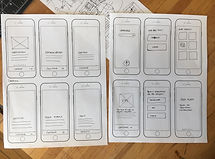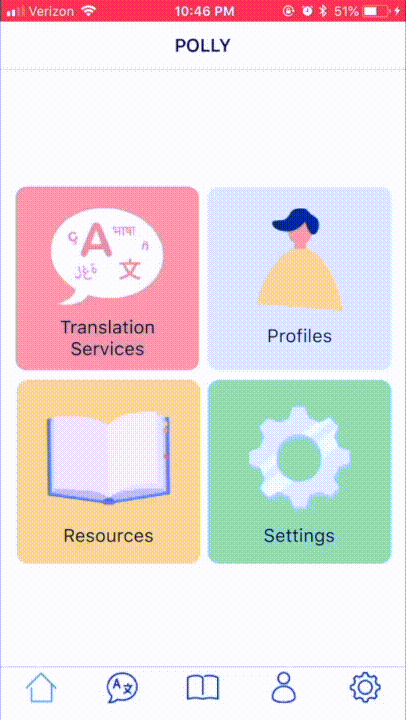Pocket Course Development
We reached out to professional translators to get a sense of their training and experience to build out this “crash course” of professional tips. Ultimately, following their guidelines and through additional research, we developed the content for our crash course. We have designed it in 4 languages so far.




POLLY
Challenge
Inaccuracies in medical translation can lead to misinformed, dangerous decisions about a patient's health. Yet oftentimes, patients will ask their unqualified bilingual caretaker to step up as a temporary or "ad hoc" translator in place of a professional, due to logistical limitations or their own discomfort.
Outcome
POLLY is a service that facilitates communication between Low English Proficiency (LEP) patients and their doctors by providing interpretation training and resources.
FINAL DELIVERABLES


Pocket Course
The pocket course is designed for the ad hoc interpreter. It aims to provide this user with professional training to bring attention to common errors and recommended best practices in medical translation. It is intended to be the initial touchpoint for users who are discovering POLLY, and available in many languages.
Mobile App
The mobile app offers POLLY's full services: Translation Services, Patient Profiles, and Resources. With these features, the app aims to support ad hocs in their role as caretaker and making their job easier, enabling them to request professional translators ahead of time, help translate more effectively, keep track of important information to share with doctors, and more.



RESEARCH
Ad hoc Interviews
From a niche scenario case of trying to translate a Korean word for "epilepsy" to English, we realized that common available tools like Google Translate did not have the cultural or technical sensitivity needed for high quality medical translation. In this regard, a human translator was currently irreplaceable. After recognizing that the role of an ad hoc was common in the medical field, we reached out to find out about different experiences people had as translators.
We synthesized our findings and soon realized that it was difficult to define a “typical” doctor’s visit due to the varying circumstances of our users.
We identified 3 key findings:
-
Second generation children of immigrant parents often served older family members as translators, their ages ranging anywhere from 9 to 30.
-
Federally funded centers are technically required to offer professional translation services, but many do not, as the laws are not enforced. As a result, many patients end up relying on ad hoc translators.
-
There is a high correlation between LEP and at-risk status. "At-risk" refers to patients who are uninsured, undocumented, or of low-SES background.


Expert Interviews
Speaking to local health centers and hospitals helped us set us set realistic constraints and expectations for this project. We were able to see a bit into how healthcare works and design with the existing system in mind.
-
First, we found a Pittsburgh-based Immigrants & Internationals Initiative committed to providing immigrants and LEP residents access to healthcare and the ability to advocate for their rights to competent services. This finding encouraged us to find experts near us who might be familiar with our problem space.
-
We talked to a diverse range of health center who served different needs and saw different levels of visibility of LEP patients within their communities. For example, UPMC St. Margaret Bloomfield-Garfield Family Health Center serves a medically underserved area with many LEP and low-SES patients. the doctors are knowledgable about the immigrant demographics in the area and have measures in place to serve patients in many different languages.
-
On the other hand, UPMC in Aspinwall has a low visibility of LEP patients, but they have a higher elderly population and their patients struggle with health literacy. Here, we took away insights about addressing LEP problems as more general health literacy problems as well.
-
Of all the health centers we talked to, the Squirrel Hill Health Center catered the most to LEP patients. Many if not all immigrants in Pittsburgh pass through there, and their multi-lingual staff provides primary and preventive healthcare and case management for patients of all ages. We were also impressed by the network they had built with other local services, allowing them to refer patients to these partners with care and confidence.
Stakeholder Map
Initially, we placed the patient at the center of the map as the central stakeholder for whom the system is designed. However, as we developed further we felt that POLLY was really the component connecting all the stakeholders.

Service Blueprint
The service blueprint explores the interactions between the patient, their caretakers, doctors, pharmacists, specialists, and the POLLY system. Click on the image to magnify.

PROCESS
Teammates: Lily Kim, Helen Kim, Sophie Zhao
Role & Contributions: User research, brainstorming and concept ideation, prototyping, visual design
Carnegie Mellon University | Spring 2018
App Development
We developed the app from paper prototypes to actual build. We designed as we researched and made changes continually. In the process, I helped define the app's function, research what features to design, create wireframes and mockup screens, write copy, and provide assets for our developers.




Requesting a translator


Translation training course


User profile



FUTURE CONSIDERATIONS


Feedback
We returned to SHHC to show our finished deliverables to the staff, who previously helped us with our research. They responded positively to the fact that the Pocket Course attempts to educate patients about their rights to language services, and they liked the integration of an app. However, we realized that this particular health center strongly opposes the use of an ad hoc translator, so they might appreciate even more emphasis on the translation resources that are available and recommended for LEP patients to use.
Other Desired Outcomes
If we had time to develop POLLY further, we would love to investigate partnerships with existing medical translation services and Pittsburgh's healthcare infrastructure. We would like to culminate relationships with health and relocation centers to build a trusted network of resources for LEP clients. Additionally, throughout the course of the project we have learned how diverse medical needs are in different geographic areas, so we would like to explore designing POLLY for unique and localized needs.
-
Defining a problem and its constraints, audience, physical context and assumptions
-
Navigating a problem space dealing with sensitive topics and "red tape" research
-
Identifying key insights from various methods of design research
-
Conducting research and creating iterative designs in parallel
-
Designing a system that flows across different platforms and multiple systems